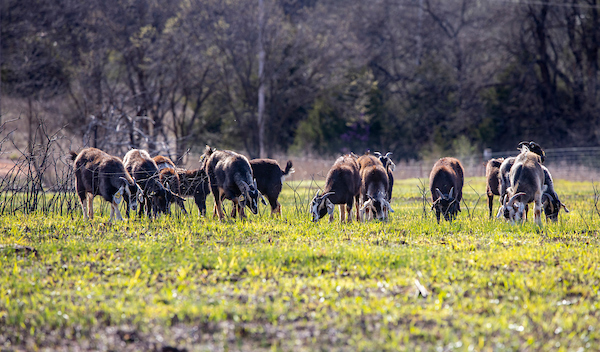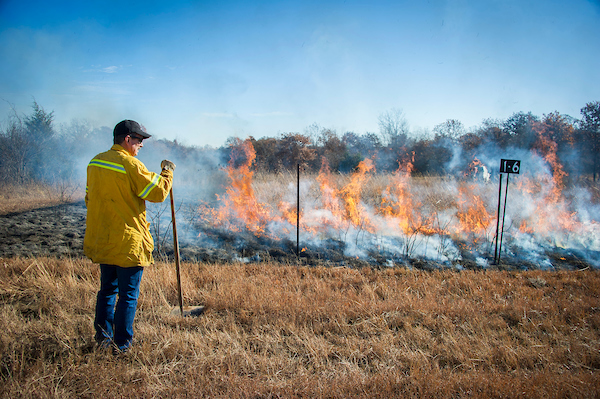Range Research Station
Research Focus
The OSU Range Research Station focuses its research efforts on natural resources and ecological management with an emphasis on the effects of prescribed fire on vegetation, wildlife, and cattle grazing distributions in the Cross Timbers eco-region.
Conservation and natural resource management are the major r esearch themes at the OSU Research Range. Prescribed fire studies are designed with
both temporal and spatial variances in an effort to maintain and restore native plant
and animal communities to the area. In addition to hosting numerous research trials,
the Range Research Station also serves as a natural resources management demonstration
and educational facility used by many professors, extension personnel, and visiting
tour groups each year. Topics such as fire management, wildlife management, and eco-tourism
are showcased to help students and landowners maximize their knowledge and determine
the practices necessary to increase productivity of their land base. Research data
collected from this station is not only being utilized locally but the information
generated is used regionally, nationally, and worldwide to support land owners management
decisions.
esearch themes at the OSU Research Range. Prescribed fire studies are designed with
both temporal and spatial variances in an effort to maintain and restore native plant
and animal communities to the area. In addition to hosting numerous research trials,
the Range Research Station also serves as a natural resources management demonstration
and educational facility used by many professors, extension personnel, and visiting
tour groups each year. Topics such as fire management, wildlife management, and eco-tourism
are showcased to help students and landowners maximize their knowledge and determine
the practices necessary to increase productivity of their land base. Research data
collected from this station is not only being utilized locally but the information
generated is used regionally, nationally, and worldwide to support land owners management
decisions.
Size and Location
The Range Research Station consists of approximately 5,000 acres located southwest of Stillwater, OK.
There are nine properties ranging in size from around 160 to 2000 contiguous acres which accommodate both landscape level and small scale research trials and provide relevance to both large and small landowners. You can find more information on each individual property by following the links in the sidebar. The Headquarters of the Range Research Station can be found by traveling 8 miles west of Stillwater on Highway 51, and then 2.5 miles south on Coyle Road. The entryway to the station is located on the west side of the road and can be recognized by a large OSU brand painted on the side of the shop. It is policy at the OSU Range Research Station for ALL personnel and visitors to check in at the headquarters before accessing any properties managed by the Station. Safety is the number one reason for checking-in as the extremely rough terrain on the Station can pose a hazard to personnel, vehicles, and equipment. Having property access records at a glance will help us to locate individuals in an emergency situation.
The Range Research Station is located in the western part of the Cross Timbers ecosystem
which occurs from southeastern Kansas to north central Texas. The Cross  Timbers ecosystem is a mosaic of upland deciduous forest, savanna, and Tallgrass prairie
that typifies the broad region between the eastern deciduous forest and the grasslands
of the southern Great Plains. The pre-settlement Cross Timbers may have covered some
20,090,638 acres and today may represent the least disturbed forest ecosystem of comparable
size still left in the eastern United States. Vegetation types of the area consist
of upland hardwood forest dominated by blackjack (Quercus marilandica) and post oak (Quercus stellata) occurring on coarse-textured soils with interspersed Tallgrass prairie
occurring on fine-textured soils. Annual precipitation for the Station averages 36.71
inches with a peak in rainfall normally occurring in May. Average temperatures for
the region vary greatly from season to season with summer temperatures around 94°F
and winter temperatures around 30°F. Soil textures and structure vary greatly across
the Station properties and specific site soil information can be found linked to each
property’s page below.
Timbers ecosystem is a mosaic of upland deciduous forest, savanna, and Tallgrass prairie
that typifies the broad region between the eastern deciduous forest and the grasslands
of the southern Great Plains. The pre-settlement Cross Timbers may have covered some
20,090,638 acres and today may represent the least disturbed forest ecosystem of comparable
size still left in the eastern United States. Vegetation types of the area consist
of upland hardwood forest dominated by blackjack (Quercus marilandica) and post oak (Quercus stellata) occurring on coarse-textured soils with interspersed Tallgrass prairie
occurring on fine-textured soils. Annual precipitation for the Station averages 36.71
inches with a peak in rainfall normally occurring in May. Average temperatures for
the region vary greatly from season to season with summer temperatures around 94°F
and winter temperatures around 30°F. Soil textures and structure vary greatly across
the Station properties and specific site soil information can be found linked to each
property’s page below.
Meet the Team
- Matt Sparks
Field Supervisor - Kallin Crile
Farm/Ranch Hand II
